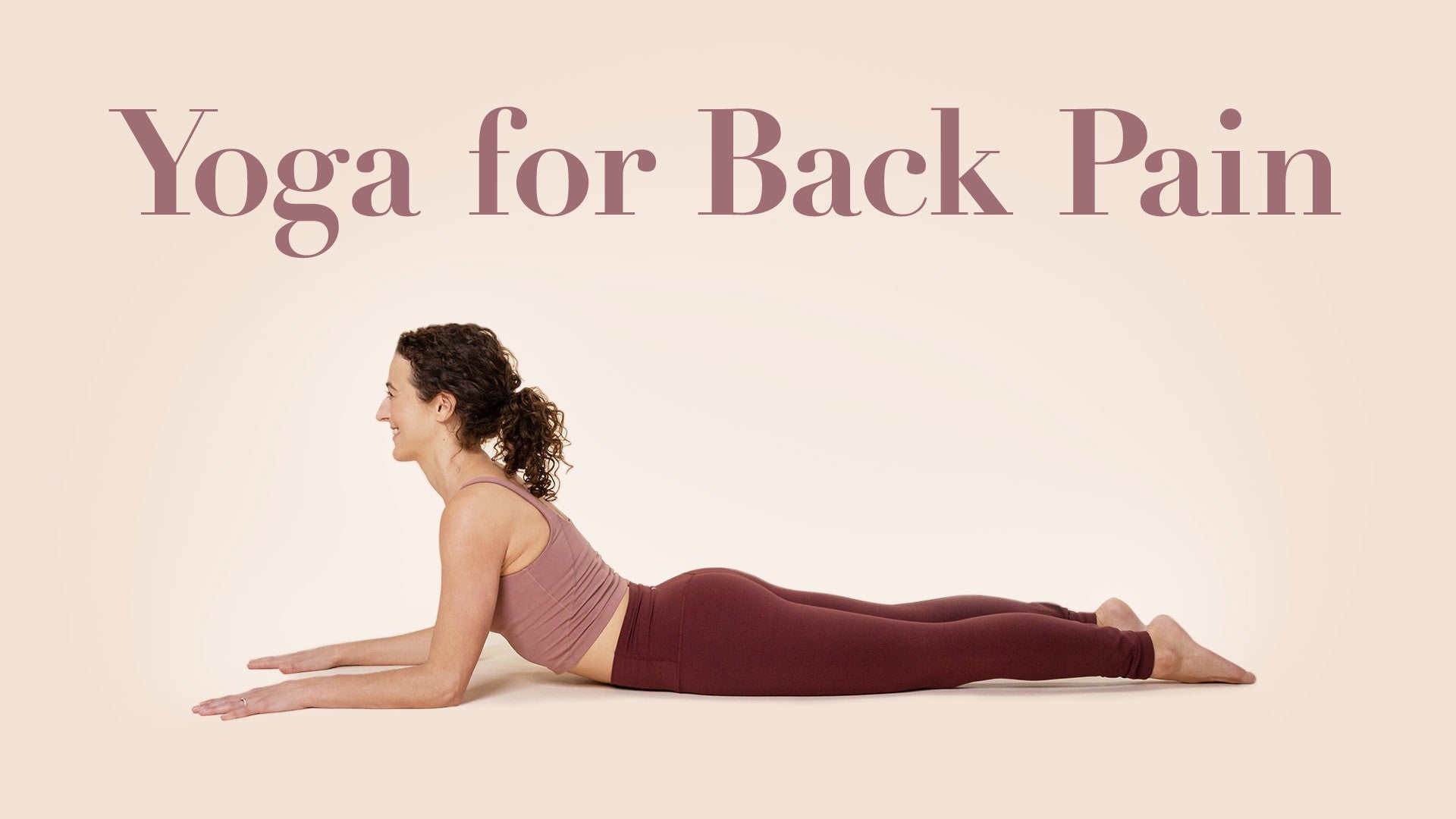Description
About This Video
Transcript
Read Full Transcript
Hi. My name is Olivia, and we now live in the age of devices. And a lot of us are spending a lot of time looking down, you know, the head in front of the spine. And this looking down creates a lot of tension in the neck and starts to malalign the joints. And so this class is a remedy and will help you recover and rehabilitate your neck To start, you'll have a couple of blankets, couple of blocks, and a strap, and we'll take the neutral cervical curve with some thoracic extension. This helps already to get the head back. So one blanket, long rectangle, And you're actually just going to put your rib cage on the blanket, not the lower Barry.
And your second blanket, roll it up about a third to a half of the way And you have, like, a tail there, and that tail will be a pillow for your head, and this roll is for your neck. So you can put the roll about midway on the blanket beneath. And then scoot your hips. Yeah. 6, 8 inches from the blanket and ribs on the blanket, and then adjusting the neck, the cervical roll. So that it is indeed under the neck. And the roll should be the height where it touches your neck, but it's not actually pressing up on the neck. It just meets your cervical curve.
And then not so high that your head doesn't quite touch the ground, or rather than the ground, that blanket, that pillow that's under the head. So the head is touching the blanket, The blanket is touching your neck and your ribs are supported. Taking your arms to your sides, tuck the shoulder blades under. Let the collar bones spread. Lower the gaze or close the eyes.
The feet can be a little bit wider than your hips. Relax your legs. Let your legs turn out. They will, when they relax, get heavy through the legs and the pelvis, heavy through the arms and the shoulders, heavy through the rib cage, heavy through the head. Light in the breath. Allow your neck to soften around the roll beneath it.
So that the curve and the cervical spine returns, and the head has the sense of releasing down. So instead of our head always out in front of us, like it tends to be with our devices, the head is a little bit lower or behind the neck here. Also, when we hold our devices, we tend to round the shoulders forward. Here, the shoulders are releasing. Chest is open. Letting this shape imprint on you.
So that this becomes again our sense of normal. Let your next breath be deeper. Exhale slowly and then bend your knees. Place your feet flat on the mat roll over to your side and come up off of your blankets. We'll sit on them.
So you can take the rolled up one and fold it like the other, or if you have a bolster, you could use that too. And you'll need your strap. There's a loop in it. You can take that out. So it's just a long free strap.
And find a comfortable seated position. And then we'll take the head and move it in all the ways that the neck can move the head just as a range of motion motion check. So We're not trying to do anything in particular here, just feeling into what the range of motion is. So go ahead and take your head down. Notice how that feels, look down.
And then look forward and look up. Notice how that feels. Look forward tilt your head to the right, bring the crown of the head up over to the left, lift through the crown of the head, turn, rotate the head, look to the right, looking over the right shoulder, and then to the left, and then look forward and take your whole head forward and chin retraction whole head back and then release. Alright. We're gonna take the strap now up and over and around the neck. So we'll start with the strap around the lower neck near the upper trapezius. And you're going to pull down and forward on the neck bones.
Now usually our head is down and forward looking down at our cell phones, but instead we're gonna reverse that. We're gonna take our instead of our neck bones being behind the head, we're gonna take the neck bones forward. So pull forward forward and slightly down with your hands and take your head back the other way. And then look forward. And then again, loosen on the strap, then tighten forward on it. Head goes back up and over the strap, and then lift the crown of the head up.
One more time loosen on the strap, and then pull forward as you take the head Barry. Look forward. Now wiggle the strap a bit higher to the middle of the neck. Same. The strap will come forward. You pull forward slightly up.
Head goes back. And then again, so you don't need to hold the head up here. When you take your head back, let it go up and over the strap and almost hang down behind the strap. So that the joint mobilization comes. You're moving the bones forward in the spine. And then, hence, the skull goes back and look forward. Alright.
Now let's take the strap to the highest part of the neck near the base of the skull. Now Barry much it's forward and up. Forwarding up with the hands. Head same goes back. Look forward.
And then again, loosen, tighten, forward and up. Head goes back. Keep pulling forward as the head goes up. One more time, loosen, pull forward, head goes back, lift, forward, and up with the strap, and then look forward. And we're gonna go back down to the bottom of the neck, all the way down. Near the shoulder is now same.
You're gonna draw the strap forward and down. Take your head back, but now keeping the head back, keeping the tension forward on your strap, rotate your head to the right, and then rotate your head to the left. And then look forward and keep pulling forward as you come up. So only when you're up, do you release that tension? Move the straps to the middle of the neck, pull forward slightly up. Keep that head goes back.
Rotate to the right, arms are steady, stable, rotate to the left, head comes forward, and lift the crown of the head up pulling forward on the strap, one more time at the highest height, bring the strap just under the base of the skull. Now it's forward and up with the hands. Take the head back. Rotate to the right. Rotate to the left.
Come center and pull the straps forward to help lift the head up. Alright. Now back to the middle. Lower the strap on the right. Keep the strap on the left parallel to the floor, and then you're gonna change hands. So the right hand to the strap on the left, left hand to the strap on the right, pull down with your left hand, and you're going to pull with your right hand to the right and let the neck and head follow, and then come to the center.
Pull side and center. Pull side and center. So the strap is pulling on the neck and the head, encouraging the joints to move, and back to the center, and then we'll change. So releasing the strap changing hands. And this, now this left hand lifts up to the high strap that's on the right side of your neck, and the right hand will hold the low left strap. Take a breath in.
And exhale here, we got leading with the left hand with the strap. Head follows and turns. Come back to the center. Leading with the strap. Pull the neck bones around. You're actually drawing the right side of the cervical spine forward to help turn the head.
And then come back to the center and release the straps. Place your hands on your thighs. We're gonna go back to our neck range of motion check and see how it feels now. So look down. And then look up, look forward, and then tilt the head to the right, tilt your head to your left, and turn look over the right shoulder, look over the left shoulder, Uncome forward, head forward, and head back.
Okay. So the ones we mainly facilitated, we're looking up and rotating. So chances are those maybe improved in their range of motion or maybe decrease in pain, that would be great. But even some of the other ones when the neck starts moving, not always forward with the cell phone with the head, then everything can improve in the next. So we're gonna take this concept into some yoga poses now. So, some asana. And so you can set your strap aside and we'll come back to it and set also the blankets aside.
We can bring the blocks near the front of the mat, off of the mat, they're there for you, and then find your way into auto mokushvanasana, downward facing dog, Let's bring the neck like the rest of the spine into a neutral shape. Hold your ears between the upper arms. Reach the crown of the head towards the space between the hands. And draw your hips back. And then lift your heels, lower your knees down, and step the right foot forward.
Here, you could take your blocks. Release the pelvis down. Walk your hands up to your right thigh. And you'll take your hands and interlace the hands behind the neck. So like the strap, draw your elbows forward, scissor the inner thighs together, firm the lower belly and then lift up through the elbows and the chest, and the head can tilt back and lean onto the pinky sides of the hands.
Impella's forward, head Barry, inhale, exhale, lift the head, release the hands down, and change sides. We'll take the right leg Barry, and step the left forward. Releasing the pelvis down. Walk your hands to your left thigh. Cesar, the inner thighs together. And this time interlace the fingers and bring your hands behind the head.
Draw the elbows forward and let the head go back into the hands conscious now of what the neck is doing. So many times, we've had something helping the neck bones go forward. And so feeling your way into that, the head goes back, the cervical bones, and the neck move forward. Lift the chest. Exhale.
Slowly come out. Hands come down to the blocks, and then you can set your blocks aside. And we'll work a little bit with knees chest chin. So this is one way of coming down to the floor, and it does accentuate the same movement of the head that is the the repair for technique. And so coming down with the chest as you bend your elbows, reach your chest forward.
The hips stay up. The chest comes down. The chin comes down. Cervical bones are down, the head is relatively up. And then almost like a snake, you slither through, pull the chest forward and up.
And again, we're looking up in our cobra. Inhale. Exhale. Lifting in the belly, hands, and knees. Tuck the toes under downward facing dog. Let's do it again.
Inhale to plank, exhale lower your knees, bend your elbows, take it slow, chest and shin come down, and then keep the face forward as you slid or through, maybe come up a little higher, lift the head. Exhale firm the belly downward facing dog. Again, inhale to your plank, lower the knees, exhale, lower the chest and the chin. And then slither through. This time, walk your forearms forward, come up on your forearms, and turn your palms to vase up to the ceiling.
Spread the thumbs. Spread the collar bones. Reach back through your legs. Take the tailbone, the pubis down, scoop the belly up, and then begin to let the shoulder blades cup the spine. And notice how that starts the lift of the chin.
And so there's a connection, a strong connection between the state of the shoulders and the state of the neck. And so we begin ideally the lift of the chin from the lift of the chest, and we begin the lift of the chest from the upper back. So right in between the shoulder blades, melt forward, lift the chest, and then the chin goes up, and awareness of the cervical bones and the thoracic bones moving forward as your skull bone, that's the one that moves back. Coming down. Go ahead and take the head down. We'll take the hands wide, come up on the fingertips, elbows up over the wrists.
Hands are wide, so they're about shoulder height. Pressing down through the fingertips, start to lift the chest and the head off the floor. And let's take that sequentially now. Their acid spine into the chest, lift the chest, cervical spine towards the front of the neck, lift the chin, inhale, exhale, come back down. Take it again, lifting in the chest, thoracic spine moves forward, cervical spine forward, chin goes up, and exhale come down one more time. It's like an unfolding inhale.
Coming up, thoracic spine forward, chest forward, cervical spine forward chin up, and exhale come down option to do that again, or take upward facing dog, noticing the similarities. And exhale all the way down. Press to hands and knees, tuck your toes under, downward facing dog, and then walk your feet forward to your hands. Lift your hands to your hips and slowly stand. Take your strap.
Alright. So we'll bring those concepts now with us into some standing poses. Feet hip distance or feet together. And we'll start with the strap behind the hips. You can either just grip it with the fingers or hold on to it tightly between the thumb and the index finger. Either way.
And then pull out a little bit. Pull out on the strap with the hands so that we find, again, the opening of the chest and the shoulder blades start to cup the spine, the thoracic spine. And then with that, there's the lift of the chest and naturally some lift of the chin. Alright. Now release. And bring your strap behind your neck.
Alright. Now we're gonna just take the neck bones forward and up again and lift the chin, head goes back, cervical bones forward, lift the chest, look up. And then pulling forward with the hands. Look forward. Alright. Net then you could just release your strap down. Take your arms to this side. Turn your palms to face the ceiling.
And now we're gonna do all of it together. Thoracic spine forward, chest up, cervical spine forward, head and arms up, Ordva hastasana. Exhale, lowering the arms down, look forward. Alright. Let's try that in utkatasana. Again, feet can be a part or together.
Shift the hips back. Shift the weight into the heels, pull forward about mid neck, pull forward with the strap, and then lift the head, look up. So in the final version of this pose, we look up, but it's hard. And so focusing on how right now, let it come from between the shoulder blades forward, then the chest, then cervical bones, you're pulling them forward. Head goes back, and then lower your strap.
Take your arms to the side. Lift your arms up. Straighten the legs and lower the arms. Let's step the left foot back, right foot forward, and try it in warrior 1. It's another pose where classically we look up.
Let's try, bend the right leg. And now it just interlace the fingers or keep the hands on the hips, and we'll find that cupping of the shoulder blades to the spine, which actually is not present when the arms go up, but we can feel so easily hear how the thoracic spine moves forward, which still needs to happen when the arms go up and then switch hands to strap pull forward, take the cervical spine forward, chest, and head chest and chin go up. And then you can stay there. Just feel into that or release the strap and take the arms up and bind it again, but with the arms up, view of address in 01. And release second side, same neck, step the left foot forward, right foot back, bend the left knee, interlace the fingers or hands on the hips, roll the shoulders notice thoracic spine easily moves forward.
Chest opens. Chest lifts. You might feel the chin. Start to lift. The gaze wants to go up. There's a whole lot that needs to happen in the belly too, and you can check-in with some of the other sequences in this show, show series that talk about how to engage the core, but we're up in the realm of the upper back now. And it's all about opening, opening the front of the chest, the front of the back, the front of the neck, And so now taking the strap, pull forward. And as he lift the chin, the front of the neck opens, normally, so close there, and then possibly release the strap and lift your arms up via a bedrostenal one.
And release hands on the hips, step the right foot forward, and remove the strap. Okay. We're gonna go back to Sirya Namascar. I'm just standing at the front of the mat, turning the arms out. Here we go. Lifting the arms up.
Inhale. Feel through the upper back. The neck as you look up. Exhale and fold. Here it is again. We look forward. Chin forward. Chest forward.
Breathe in. Exhale. Step back to plank. Inhale and plank, and exhale knees, chest, chin, slither through to low cobra, upward facing dog, thoracic spine forward chest up, cervical bones forward chin up, Exhale downward facing dog. Inhale. Come back to your plank, and this time just come all the way down. Reaching your arms Barry.
So a couple choices here. One could be to take the strap and hold it again. So between the thumb and the index finger, just grab it. It's behind the pelvis or over the pelvis. Another is to bend the knees, catch your ankles from the outside, And then everybody spread the collar bones, thoracic melts towards the chest, and then start to lift the head, the chest, try to lift the thighs. If you hold your ankles, you can press your feet Barry.
And notice that here we are again, same paradigm. Their acid spine melts forward. Surgical spine can melt forward. Ching can lift, and you can look up. Inhale, get tall, an exhale release. So this is present in a lot of backbends So Barry ends can help us a lot with technique.
You might continue with Don Your Asana. Otherwise, you can join me to try Ostrasana, which of all of the poses might be the one where we release the head the most. Tucking the toes under is an option. Makes the heels higher. Hands on the hips. Let's bring me all those back.
Cup the thoracic spine with your shoulder blades. Thoracic spine moves into the chest. Lift the chin and then start to lean back so you can bring your hands to your heels or you can keep them on your hips. And then one more time, lift your chest up to the ceiling. Lots of thoracic movement towards the chest.
And as your head goes back, be mindful of what happens in the neck, those bones, neck bones move towards the front of the neck. Inhale. Coming up and exhale. You can sit down and rest on your heels. Alright. Now everybody coming onto your hands and your knees. We'll take a little bit of cat and cow to start to move the spine out of the backbends.
So cow will come very easily. Cat might feel a little bit stiff to get slow on the breath. And then try it down on your forearms. Same spinal movement. Come back up on your right hand, straighten the right arm, weave the left arm under, lower down onto the left side of the head, and you'll press through the right hand.
And take a twist. Neck is relaxed. Head is on the floor, but you're turning through the mid spine. Sometimes the pelvis also wants to go to the right here. So move the pelvis back to the center a little bit off to the left. And then slowly come up.
Left hand goes to the floor, right arm, leaves under right side of the head down on the mat, if possible, right in the center of the mat. And similar with the pelvis, it wants to shift left, bring it back to the right to the center. Left hand presses into the earth and turn the left collarbone up to the ceiling. Relax through the neck head resting. And release coming up onto your hands and your knees.
If your knees are sensitive in child's pose, just rock back and forth. If they're okay, sit down all the way down. On the feet and relax the elbows to the mat. Rest your head on something, be it the mat or prop so the neck again can relax. Notice the jaw, notice the tongue.
Notice your temples. Encourage a letting go. And we'll take our Shivasana the same way we started the class. Again, it's like a little check to see. How does this land with me now? Same pose, but after all of that awareness and insight, the same setup. We had the one blanket under the ribs and the rolled up blanket under the cervical curve, and then the head resting.
So take a moment, find that. Gonna adjust the buttocks towards the feet, tap the shoulder blades under a little bit, and then close the eyes. And just noticing how it sits with you now. The way you relate to the positioning of your head and your neck and your shoulders. And because this is the the area of the brain, much of the spinal cord, we can often experience a a real neurological shift when we get it right in the shoulders and the neck or just get it better.
There can be a lot of tremendous relief with more oxygen going to the brain and better ability to to breathe into the chest. Diaphragm has an easier time functioning when our posture improves. And you might wanna spend 5, 10, 20 minutes here. And then you'll bend your knees and turn to your side. Slowly come up.
Thank you. Namaste.
Yoga for Back Pain: Managing Back Pain
Comments
You need to be a subscriber to post a comment.
Please Log In or Create an Account to start your free trial.













